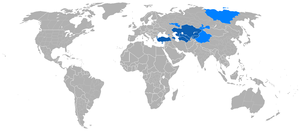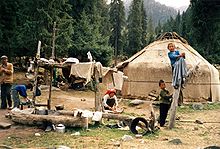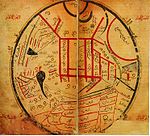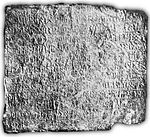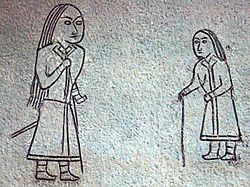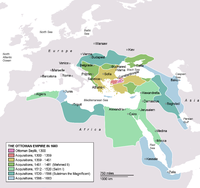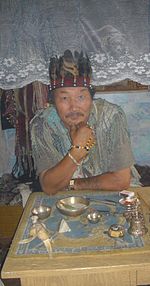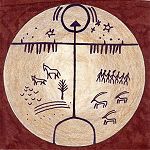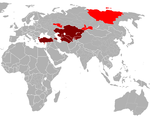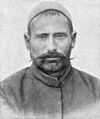- Turkic peoples
-
Turkic peoples Total population Approximately 160 million[citation needed] Regions with significant populations  Turkey
Turkeyc. 55,000,000 (70-76% of total country pop.)[1][2]  Uzbekistan
Uzbekistan24,000,000 (90% of total country pop.)  Iran
Iran20,251,000 (26% of total country pop.)[3]  Kazakstan
Kazakstan11,000,000 (70% of total country pop.)  China
China11,647,000 (0.8% of the total country pop.)  Russia
Russia10,431,000 (6% of total country pop.)  Azerbaijan
Azerbaijan9,047,000  Turkmenistan
Turkmenistan4,500,000[4] (90% of the total country pop.)  Kyrgyzstan
Kyrgyzstan4,500,000 (90% of the total country pop.)  European Union except Bulgaria and Greece
European Union except Bulgaria and Greece5,210,000  Iraq
Iraq1,500,000 (5% of the total country pop.)  Afghanistan
Afghanistan982,000[5]  Bulgaria
Bulgaria801,200 c  United States
United States523,000  TRNC
TRNC298,862  Australia
Australia293,500  Ukraine
Ukraine275,300[6]  Saudi Arabia
Saudi Arabia224,460  Greece
Greece178,000 h  Moldova
Moldova158,300  Macedonia
Macedonia82,959  Pakistan
Pakistan62,100[7] The Turkic peoples (also Turkics and Turks) are peoples residing in northern, central and western Asia, southern Siberia and northwestern China and parts of eastern Europe. They speak languages belonging to the Turkic language family.[8] They share, to varying degrees, certain cultural traits and historical backgrounds. The term Turkic represents a broad ethno-linguistic group of people including existing societies such as the Turkish, Azerbaijani, Chuvashes, Kazakhs, Tatars, Kyrgyzs, Turkmen, Uyghur, Uzbeks, Bashkirs, Qashqai, Gagauzs, Yakuts, Crimean Karaites, Krymchaks, Karakalpaks, Karachays, Nogais and as well as past civilizations such as the Kumans, Kipchaks, Avars, Bulgars, Turgeshes, Seljuks, Khazars, Ottoman Turks, Mamluks, Timurids, and possibly the Xiongnu and Huns.[8][9][10]
Contents
Demographics
The distribution of people of Turkic cultural background ranges from Siberia, across Central Asia, to Eastern Europe. Presently, the largest groups of Turkic people live throughout Central Asia—Kazakhstan, Kyrgyzstan, Turkmenistan, Uzbekistan, and Azerbaijan, in addition to Turkey and Iran. Additionally, Turkic people are found within Crimea, East Turkistan region of western China, northern Iraq, Pakistan, Israel, Russia, Afghanistan, and the Balkans: Moldova, Bulgaria, Romania, and former Yugoslavia. A small number of Turkic people also live in Vilnius, the capital of Lithuania. There is also a small number in eastern Poland and southeastern part of Finland.[11] There are also considerable populations of Turkic people (originating mostly from Turkey) in Germany, United States, and Australia, largely because of migrations during the 20th century.
Sometimes the above list is grouped into six branches: the Oghuz Turks, Kipchak, Karluk, Siberian, Chuvash, and Sakha/Yakut branches. The Oghuz have been termed Western Turks, while the remaining five, in such a classificatory scheme, are called Eastern Turks.
One of the major difficulties perceived by many who try to classify the various Turkic languages and dialects is the impact of Soviet and particularly Stalinist nationality policies—the creation of new national demarcations, suppression of languages and writing scripts, and mass deportations—had on the ethnic mix in previously multicultural regions like Khwarezm, the Fergana Valley, and Caucasia. Many of the above-mentioned classifications are therefore by no means universally accepted, either in detail or in general. Another aspect often debated is the influence of Pan-Turkism, and the emerging nationalism in the newly independent Central Asian republics, on the perception of ethnic divisions.
All the Turkic peoples native to Central Asia are of mixed Caucasoid and Mongoloid origin. Of these Central Asian Turks, Kazakhs and the Kyrgyz are closer to Mongoloids racially. Karakalpak are mixed almost evenly. Uighur in Xinjiang China, Uzbek and Turkmen are more close to Caucasoid. The genetic distances between the different populations of Uzbeks scattered across Uzbekistan is no greater than the distance between many of them and the Karakalpaks. This suggests that Karakalpaks and Uzbeks have very similar origins. The Karakalpaks have a somewhat greater bias towards the eastern markers than the Uzbeks. Reference: The Karakalpak Gene Pool (Spencer Wells, 2001) & Discussion and Conclusions at www.karakalpak.com/genetics.html
The Turkic people display a great variety of ethnic types.[12] They possess physical features ranging from Caucasoid to Northern Mongoloid. Mongoloid and Caucasoid facial structure is common among many Turkic groups, such as Chuvash people, Tatars, Kazakhs, Uzbeks, Hazaras, and Bashkirs. Historically, the racial classification of the Turkic peoples was sometimes given as "Turanid". Western (Anatolian) Turks are largely the genetic descendants of Turkified/Islamized Indo-European/Semitic groups such as Armenians, Kurds, Jews, Greeks, Assyrians, Arabs, and Slavs.
The following is an incomplete list of Turkic people with the respective groups's core areas of settlements and their estimated sizes (in million):
People Region Population Modern Language Turkish people Turkey, Germany, Bulgaria, Georgia, Syria, Iraq 70 M Turkish Azerbaijanis Azerbaijan Republic, Iran, Turkey, Russia, Georgia 22 to 30 M Azerbaijani Uzbeks Uzbekistan, Afghanistan, Pakistan, Tajikistan, Kazakhstan, Kyrgyzstan, Turkmenistan 28,3 M Uzbek Kazakhs Kazakhstan, Russia, China, Uzbekistan 13.8 M Kazakh Uyghurs China (Xinjiang), Kazakhstan, Uzbekistan, Kyrgyzstan, Pakistan, Turkey 9 M Uyghur Turkmens Turkmenistan, Pakistan, Iran, Afghanistan, 8 M Turkmen Tatars Russia, Uzbekistan, Kazakhstan, Tajikistan, Poland, Lithuania, Finland 7 M Tatar Kyrgyzs Kyrgyzstan, Pakistan, Afghanistan, Uzbekistan, China, Tajikistan 4,5 M Kyrgyz Bashkirs Russia, Uzbekistan, Kazakhstan 2 M Bashkir Crimean Tatars Ukraine (Crimea), Russia, Uzbekistan, Turkey, Romania 0.5 to 2 M Crimean Tatar Qashqai Iran 1.7 M Qashqai Chuvashes Russia 1.7 M Chuvash Karakalpaks Uzbekistan, Kazakhstan, Turkmenistan 0.6 M Karakalpak Yakuts Russia 0.5 M Sakha Kumyks Russia 0.4 M Kumyk Karachays and Balkars Russia, Turkey 0.4 M Karachay-Balkar Tuvans Russia 0.3 M Tuvan Gagauzs Moldovia 0.2 M Gagauz Crimean Karaites and Krymchaks Lithuania, Poland, Russia, Turkey 0.2 M Karaim and Krymchak Geographical distribution
Many of the Turkic peoples have their homelands in Central Asia, where the Turkic peoples settled from China. According to historian John Foster, "The Turks emerge from among the Huns in the middle of [the] fifth century. They were living in Liang territory when it began to be overrun by the greater principality of Wei. Preferring to remain under the rule of their own kind, they moved westward into what is now the province of Kansu. This was the territory of kindred Huns, who were called the Rouran. The Turks were a small tribe of only five hundred families, and they became serfs to the Rouran, who used them as iron-workers. It is thought that the original meaning of "Turk" is "helmet", and that they may have taken this name because of the shape of one of the hills near which they worked. As their numbers and power grew, their chief made bold to ask for the hand of a Rouran princess in marriage. The demand was refused, and war followed. In 546, the iron-workers defeated their overlords."[13] Since then Turkic languages have spread, through migrations and conquests, to other locations including present-day Turkey. While the term "Turk" may refer to a member of any Turkic people, the term Turkish usually refers specifically to the people and language of the modern country of Turkey.
The Turkic languages constitute a language family of some 30 languages, spoken across a vast area from Eastern Europe and the Mediterranean, to Siberia and Western China, and to northern edges of Pakistan and the Middle East.
Some 170 million people have a Turkic language as their native language;[14] an additional 20 million people speak a Turkic language as a second language. The Turkic language with the greatest number of speakers is Turkish proper, or Anatolian Turkish, the speakers of which account for about 40% of all Turkic speakers.[15] More than one third of these are ethnic Turks of Turkey, dwelling predominantly in Turkey proper and formerly Ottoman-dominated areas of Eastern Europe and West Asia; as well as in Western Europe, Australia and the Americas as a result of immigration. The remainder of the Turkic people are concentrated in Central Asia, Russia, the Caucasus, China, northern Iraq.
At present, there are six independent Turkic countries: Azerbaijan, Kazakhstan, Kyrgyzstan, Turkmenistan, Turkey, Uzbekistan; There are also several Turkic national subdivisions[16] in the Russian Federation including Bashkortostan, Tatarstan, Chuvashia, Khakassia, Tuva, Yakutia, the Altai Republic, Kabardino-Balkaria, and Karachayevo-Cherkessiya. Each of these subdivisions has its own flag, parliament, laws, and official state language (in addition to Russian).
The Xinjiang Uyghur Autonomous Region in western China and the autonomous region of Gagauzia, located within eastern Moldova and bordering Ukraine to the north, are two major autonomous Turkic regions. The Autonomous Republic of Crimea within Ukraine is a home of Crimean Tatars. In addition, there are several Iraq, Georgia, Bulgaria, the Republic of Macedonia, Tajikistan, Afghanistan, and western Mongolia.
In the age of nationalism, Turkic speakers were among the first Muslim people to take up Western ideas of liberalism and secular ideologies. Pan-Turkism first sprang up at the end of the 19th century in the Russian Empire and was advanced by leading Turkish intellectuals like Crimean Tatar Ismail Gasprinski, Azerbaijan philosophers like Mirza Fatali Akhundov and Tatar Yusuf Akçura, as a reaction to Panslavist and Russification policies of the Russian Empire. The first fully democratic and secular republics in the Islamic world were Turks: the ill-fated Idel-Ural State established in 1917, the Azerbaijan Democratic Republic in 1918 (both annexed and absorbed by the Soviet Union), and in 1923 Republic of Turkey. In 1991 Azerbaijan became an independent Azerbaijan Republic.
The Turks in Turkey are over 60 million[17] to 70 million worldwide, while the second largest Turkic people are the Azerbaijanis, numbering 22 to 30 million worldwide; most of them live in Azerbaijan and Iran.
Turks in India are very small in number. There are barely 150 Turkish people from Turkey in India. These are recent immigrants. Descendants of Turkish rulers also exist in Northern India. Mughals who are part Turkic people also live in India in significant numbers. They are descendants of the Mughal rulers of India. Karlugh Turks are also found in small amounts in Srinagar region of Kashmir. Small amount of Uyghurs are also present in India. Turks also exist in Pakistan in similar proportions.One of the tribe in Hazara region of Pakistan is Karlugh Turks which is direct descendent of Turks of Central Asia. Turkish influence in Pakistan can be seen through the national language, Urdu, which comes from a Turkish word meaning "horde" or "army".
Western Yugur at Gansu in China, Salar at Qinghai in China, Dolgan at Krasnoyarsk Krai in Russia, Nogai at Dagestan in Russia are the Turk minorities at the respective regions. Beauty of Yugur Culture, Beauty of the Dolgan and Northern Tungus Culture, Beauty of Yakut Sakha Culture, Beauty of Khakass Culture at youtube show the facial feature of the Turks native to Asian Russia and China
Nomenclature
The first known mention of the term Turk applied to a Turkic group was in reference to the Göktürks in the 6th century. A letter by Ishbara Qaghan to Emperor Wen of Sui in 585 described him as "the Great Turk Khan."[18] The Orhun inscriptions (735 CE) use the terms Turk and Turuk.
Previous use of similar terms are of unknown significance, although some strongly feel that they are evidence of the historical continuity of the term and the people as a linguistic unit since early times. This includes Chinese records Spring and Autumn Annals referring to a neighbouring people as Beidi.[19]
According to Turkologists Peter Golden and András Róna-Tas, the Turk term is ultimately rooted: "is East Iranian, most probably Saka, origin, and is the name of a ruling tribe whose leading clan Ashina conquered the Turks, reorganized them, but itself became rapidly Turkified".[20]
In modern Turkey, a distinction is made between "Turks" and the "Turkic peoples" in loosely speaking: the term Türk corresponds specifically to the "Turkish-speaking" people (in this context, "Turkish-speaking" is considered the same as "Turkic-speaking"), while the term Türki refers generally to the people of modern "Turkic Republics" (Türki Cumhuriyetler or Türk Cumhuriyetleri). However, the proper usage of the term is based on the linguistic classification in order to avoid any political sense. In short, the term Turkic can be used for Turk or vice versa.[21]
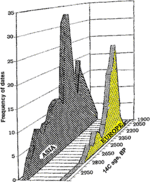 Timeline of Scythian kurgans in Asia and Europe (Per Fig.6 of Alekseev, A. Yu. et al., "Chronology of Eurasian Scythian Antiquities".[22]
Timeline of Scythian kurgans in Asia and Europe (Per Fig.6 of Alekseev, A. Yu. et al., "Chronology of Eurasian Scythian Antiquities".[22]
According to Book of Zhou, the original meaning of "Turk" is "helmet", and that they may have taken this name because of the shape of the Altai Mountains. According to Mahmud of Kashgar, an 11th century Turkic scholar, and various other traditional Islamic scholars and historians, the name "Turk" stems from Tur, one of the sons of Japheth, and comes from the same lineage as Gomer (Cimmerians) and Ashkenaz (Scythians, Ishkuz) who, according to tradition, were some of the earliest Turks. For millennia, a long string of historical references specifically linked Herodotus’ Scythians with various tribes, such as the Hunno-Bulgars, Avars, Türks, Mongols, Khazars etc.[23] Between 400 CE and the 16th century the Byzantine sources use the name Σκΰθαι in reference to twelve different Türkic peoples.[23] Paul Pelliot said Türk means powerful in Old Turkic.[24]
Alp Er Tunga is a mythical hero in Turkic tradition; the Göktürks of the 6th century carried on the tradition of Alp Er Tunga and they too had a myth according to which they themselves were descendants of a wolf.
History
Origins and early expansion
It is generally agreed that the first Turkic people lived in a region extending from Central Asia to Siberia with the majority of them living in China historically. The earliest separate Turkic peoples appeared on the peripheries of the late Xiongnu confederation (contemporaneous with the Chinese Han Dynasty).[25] Turkic people may be related to the Xiongnu, Dingling and Tiele people. According to the Book of Wei, the Tiele people were the remaining of the Chidi (赤狄), the red Di people competing with the Jin in the Spring and Autumn Period.[26] Turkic tribes, such as Khazars and Pechenegs, probably lived as nomads for many years before establishing the Göktürk Empire in the 6th century. These were herdsmen and nobles who were searching for new pastures and wealth. The first mention of Turks was in a Chinese text that mentioned trade of Turk tribes with the Sogdians along the Silk Road.[27] The first recorded use of "Turk" as a political name is a 6th-century reference to the word pronounced in Modern Chinese as Tujue. The Ashina clan migrated from Li-jien (modern Zhelai Zhai) to the Juan Juan seeking inclusion in their confederacy and protection from the prevalent dynasty. The tribe were famed metal smiths and was granted land near a mountain quarry which looked like a helmet, from which they were said to have gotten their name 突厥 (tūjué). A century later, their power had increased such that they conquered the Juan Juan and established the Gök Empire.[28]
Turkic peoples originally used their own alphabets, like Orkhon and Yenisey runiform, and later the Uyghur alphabet. The oldest inscription was found near the Issyk river in Kyrgyzstan. Traditional national and cultural symbols of the Turkic peoples include wolves in Turkic mythology and tradition; as well as the color blue, iron, and fire. Turquoise blue, from the French word meaning "Turkish", is the color of the stone turquoise still used as jewelry and a protection against evil eye.
It has often been suggested that the Xiongnu, mentioned in Han Dynasty records, were Proto-Turkic speakers.[29][30][31][32][33] Although little is known for certain about the Xiongnu language(s), it seems likely that at least some Xiongnu tribes spoke a Turkic language.[34] Some scholars see a possible connection with the Iranic-speaking Sakas,[35] while others believe they were probably a confederation of various ethnic and linguistic groups. On the other hand, genetics research from 2003[36] confirms the studies indicating that the Turkic people originated from the same area and so are related with the Xiongnu.[37] So the scientific genetic results show clearly that the Turks originated nearby the Centre-west part of modern China.
Xiongnu writing, older than Turkic is agreed to have the earliest known Turkic alphabet, the Orkhon script. This has been argued recently using the only extant possibly Xiongu writings, the rock art of the Yinshan and Helanshan.[38] It is dated from the 9th millennium BC to 19th century, and consists mainly of engraved signs (petroglyphs) and few painted images.[39] Excavations done during 1924–1925, in Noin-Ula kurgans located in Selenga River in the northern Mongolian hills north of Ulan Bator, produced objects with over 20 carved characters, which were either identical or very similar to that of to the runic letters of the Turkic Orkhon script discovered in the Orkhon Valley.[40]
The Hun hordes of Attila, who invaded and conquered much of Europe in the 5th century, might have been Turkic and descendants of the Xiongnu.[25][41][42] Some scholars argue that the Huns were one of the earlier Turkic tribes, while others argue that they were of Mongolic origin.[43] Linguistics studies by Otto Maenchen-Helfen's support a Turkic origin.[44][45] In all probability, they were closely related as the borders were not settled unlike modern times and migrations were common to distant places.
In the 6th century, 400 years after the collapse of northern Xiongnu power in Inner Asia, leadership of the Turkic peoples was taken over by the Göktürks. Formerly in the Xiongnu nomadic confederation, the Göktürks inherited their traditions and administrative experience. From 552 to 745, Göktürk leadership united the nomadic Turkic tribes into the Göktürk Empire. This was the first known political entity to be called "Turk". The name derives from gok, "blue" or "celestial". Unlike its Xiongnu predecessor, the Göktürk Khanate had its temporary khans from the Ashina clan that were subordinate to a sovereign authority controlled by a council of tribal chiefs. The Khanate retained elements of its original shamanistic religion, Tengriism, although it received missionaries of Buddhist monks and practiced a syncretic religion. The Göktürks were the first Turkic people to write Old Turkic in a runic script, the Orkhon script. The Khanate was also the first state known as "Turk". It eventually collapsed due to a series of dynastic conflicts, but the name "Turk" was later taken by many states and peoples.
Turkic peoples and related groups migrated west from Turkestan and what is now Mongolia towards Eastern Europe, Iranian plateau and Anatolia and modern Turkey in many waves.[46] The date of the initial expansion remains unknown. After many battles, they established their own state and later created the Ottoman Empire.[47] The main migration occurred in medieval times, when they spread across most of Asia and into Europe and the Middle East.[28] They also participated in the Crusades.[48]
Later Turkic peoples include the Avars, Karluks (mainly 8th century), Uyghurs, Kyrgyz, Oghuz (or Ğuz) Turks, and Turkmens. As these peoples were founding states in the area between Mongolia and Transoxiana, they came into contact with Muslims, and most gradually adopted Islam. Small groups of Turkic people practice other religions, including Christians, Jews (Khazars), Buddhists, and Zoroastrians.
Middle Ages
Turkic soldiers in the army of the Abbasid caliphs emerged as the de facto rulers of most of the Muslim Middle East (apart from Syria and Egypt), particularly after the 10th century. The Oghuz and other tribes captured and dominated various countries under the leadership of the Seljuk dynasty and eventually captured the territories of the Abbasid dynasty and the Byzantine Empire.[28]
Meanwhile, the Kyrgyz and Uyghurs were struggling with one another and with the Chinese Empire. The Kyrgyz people ultimately settled in the region now referred to as Kyrgyzstan. The Tatar peoples conquered the Volga Bulgars in what is today Tatarstan, following the westward sweep of the Mongols under Genghis Khan in the 13th century. Other Bulgars, who had initially invaded Europe in 5th-6th centuries, as part of the Hunnic tribal confederation, finally settled in Southastern Europe in the 7th-8th centuries,and mixed with the Slavic population, adopting what eventually became the Slavic Bulgarian language. Everywhere, Turkic groups mixed with the local populations to varying degrees.[28] In 1090–91, the Turkic Pechenegs reached the walls of Constantinople, where Emperor Alexius I with the aid of the Kipchaks annihilated their army.[49]
Islamic empires
As the Seljuk Empire declined following the Mongol invasion, the Ottoman Empire emerged as the new important Turkic state, that came to dominate not only the Middle East, but even southeastern Europe, parts of southwestern Russia, and northern Africa.[28]
The Mughal Empire was a Turkic empire that, at its greatest territorial extent, ruled most of the South Asia, including Afghanistan, Pakistan, India, Bangladesh and parts of Uzbekistan from the early 16th to the early-18th century. The Mughal dynasty was founded by a Chagatai Turkic prince named Babur (reigned 1526–30), who was descended from the Turkic conqueror Timur (Tamerlane) on his father's side and from Chagatai, second son of the Mongol ruler Genghis Khan, on his mother's side.[50][51] The Mughal dynasty was notable for the ability of its rulers, who through seven generations maintained a record of unusual talent, and for its administrative organization. A further distinction was the attempt of the Mughals to integrate Hindus and Muslims into a united Indian state.[50][52][53][54]
Modern history
The Ottoman Empire gradually grew weaker in the face of maladministration, repeated wars with Russia and Austro-Hungary, and the emergence of nationalist movements in the Balkans, and it finally gave way after World War I to the present-day Republic of Turkey.[28] Ethnic nationalism also developed in Ottoman Turkey during the 19th century, taking the form of Pan-Turkism or Turanism.
The Turkic peoples of Central Asia were not organized in nation states during most of the 20th century, after the collapse of the Russian Empire living either in the Soviet Union or (after a short-lived First East Turkestan Republic) in the Chinese Republic.
Chinese Turkestan remains part of the People's Republic of China, and Tatarstan, Tuva and Yakutia in the Russian Federation, but the Central Asian states of Kazakhstan, Kyrgyzstan, Turkmenistan and Uzbekistan (with ethnic Kazakh, Kyrgyz, Turkmen and Uzbek majorities, respectively) gained independence in 1991 after the disintegration of the Soviet Union.
Language
Further information: Turkic alphabets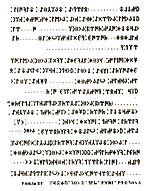 The Orkhon script is the alphabet used by the Göktürks from the 8th century to record the Old Turkic language. It was later used by the Uyghur Empire; a Yenisei variant is known from 9th-century Kyrgyz inscriptions, and it has likely cousins in the Talas Valley of Turkestan and the Old Hungarian script of the 10th century.
The Orkhon script is the alphabet used by the Göktürks from the 8th century to record the Old Turkic language. It was later used by the Uyghur Empire; a Yenisei variant is known from 9th-century Kyrgyz inscriptions, and it has likely cousins in the Talas Valley of Turkestan and the Old Hungarian script of the 10th century.
The Turkic alphabets are sets of related alphabets with letters (formerly known as runes), used for writing mostly Turkic languages. Inscriptions in Turkic alphabets were found from Mongolia and Eastern Turkestan in the east to Balkans in the west. Most of the preserved inscriptions were dated to between 8th and 10th centuries DE.
The earliest positively dated and read Turkic inscriptions date from ca. 150, and the alphabets were generally replaced by the Uyghur alphabet in the Central Asia, Arabic script in the Middle and Western Asia, Greek-derived Cyrillic in Eastern Europe and in the Balkans, and Latin alphabet in Central Europe. The latest recorded use of Turkic alphabet was recorded in Central Europe's Hungary in 1699 CE.
The Turkic runiform scripts, unlike other typologically close scripts of the world, do not have a uniform palaeography as, for example, have the Gothic runes, noted for the exceptional uniformity of its language and paleography.[55] The Turkic alphabets are divided into four groups, the best known of them is the Orkhon version of the Enisei group.
The Turkic language family is traditionally considered to be part of the proposed Altaic language family.[15][56][57][58] The Altaic language family includes 66 languages[59] spoken by about 348 million people, mostly in and around Central Asia and northeast Asia.[56][60][61]
The various Turkic languages are usually considered in geographical groupings: the Oghuz (or Southwestern) languages, the Kypchak (or Northwestern) languages, the Eastern languages (like Uygur), the Northern languages (like Altay and Yakut), and one existing Oghur language: Chuvash (the other Oghur languages, like Hunnic and Bulgaric, are now extinct). The high mobility and intermixing of Turkic peoples in history makes an exact classification extremely difficult.
The Turkish language belongs to the Oghuz subfamily of Turkic. It is for the most part mutually intelligible with the other Oghuz languages, which include Azeri, Gagauz, Turkmen and Urum, and to a varying extent with the other Turkic languages.
Shamanism and Turkic mythology
Pre-Islamic Turkic mythology was dominated by Tengriism and shamanistic religion.
The Wolf symbolizes honour and is also considered the mother of most Turkic peoples. Asena (Ashina Tuwu) is the wolf mother of Tumen Il-Qağan, the first Khan of the Göktürks.
The Horse is also one of the main figures of Turkic mythology. Türks consider the horse an extension of the human, one creature.
The Dragon, also expressed as a Snake or Lizard, is the symbol of might and power. It is believed, especially in mountainous Central Asia, that dragons still live in the mountains of Tian-Shan (Tangri Tagh) and Altay. Dragons also symbolize the god Tengri (Tanrı) in ancient Turkic tradition, although dragons themselves aren't worshipped as gods.
Geser (Ges'r, Kesar) is a Tibetan/Mongolian religious epic about 'Geser' (also known as 'Bukhe Beligte') a Turkic prophet who taught Türks the new monotheistic religion Tengriism. It is unknown when he lived, and there are not many historical documents that mention him. Tengriism isn't approved by most Muslim scholars, but sura 108 of the Qur'an has the name Al-Kawthar,in which the word kawthar could potentially be read as 'Käusar', which may be an Arabisation of the Turkic name 'Geser'. The name of this sura is conventionally interpreted as "all goods" or "abundance", but this is not certain and many scholars have different opinions on this sura.
The legend of Timur (Temir) is the most ancient and well-known. Timur found a strange stone that fell from the sky, an iron ore meteorite. He was a smith and decided to make a sword of it. Few knew about iron in Asia before then. He tried to make a sword from it by using the usual bronze sword making process. He mentioned that this material, iron, was very easy to change and manipulate, though it was even stronger than bronze. Today, the word "temir" or "timur" means "iron". The melting process was known before in Egypt and India, but it wasn't used that widely in other parts of Asia, because of the very high iron price (much higher than gold) in the Mediterranean and Europe at that time.
In Persian tradition, Central Asia is known as Turan, and the eponymous ancestor of the Turks in Persian legend is Tur, son of Fereydun.
Various pre-Islamic Turkic civilizations of the 6th century adhered to shamanist and Tengriist traditions which are reflected in the state symbols of Kazakhstan. The Shamanist religion is based on spiritual and natural elements of earth. Tengriism involves belief in Tengri as the god who ruled over the skies. Turkish: Tanrı and Azerbaijani: Tanrı remain in use by speakers of those languages as a term for God regardless of their religions.
Some Turkic peoples (particularly in the Russian autonomous regions and republics of Altay, Khakassia and Tuva) are largely Tengriists.[dubious ][citation needed] Tengriism was the predominant religion of the different Turkic branches prior to the 14th century, when the majority accepted Islam. In the Siberian region, the Altay, some Tuvan and Hakas are Tengriist, having kept the original religion of Turkic peoples.[citation needed]
Traditional Inner Asian cults, commonly referred to as shamanism, survive in many places, often submerged in other religions. In post-Soviet Siberia, 300 years after their forced conversion, some Yakuts (Sakha) and others have completely rejected Eastern Orthodox Christianity in favor of a revived shamanism.[62]
Religious conversion
Tengri Bögü Khan made the now extinct Manichaeism the state religion of Uyghur Khaganate in 763 and it was also popular in Karluks. It was gradually replaced by the Mahayana Buddhism.[63] It existed in the Buddhist Uyghur Gaochang up to the 12th century.[64]
Tibetan Buddhism, or Vajrayana was the main religion after Manichaeism.[65][66][67] They worshipped Täŋri Täŋrisi Burxan,[68] Quanšï Im Pusar[69] and Maitri Burxan.[70] Turkic Muslim conquest in the Indian subcontinent and west Xinjiang attributed with a rapid and almost total disappearance of it and other religions in North India and Central Asia. The Sari Uygurs "Yellow Yughurs" of Western China, as well as the Tuvans of Russia are the only remaining Buddhist Turkic peoples.
Many Karaims and Krymchaks of Eastern Europe (Especially Crimea) are Jewish, and there are Turks of Jewish backgrounds who live in major cities such as Istanbul, Ankara and Baku. The Khazars widely practiced Judaism before their conversion to Islam.[citation needed]
Even though many Turkic peoples became Muslims under the influence of Sufis, often of Shī‘ah persuasion, most Turkic people today are Sunni Muslims, although a significant number in Turkey are Alevis. Alevi Turks, who were once primarily dwelling in eastern Anatolia, are today concentrated in major urban centers in western Turkey with the increased urbanism.
The major Christian-Turkic peoples are the Chuvash of Chuvashia and the Gagauz (Gökoğuz) of Moldova. The traditional religion of the Chuvash of Russia, while containing many ancient Turkic concepts, also shares some elements with Zoroastrianism, Khazar Judaism, and Islam. The Chuvash converted to Eastern Orthodox Christianity for the most part in the second half of the 19th century. As a result, festivals and rites were made to coincide with Orthodox feasts, and Christian rites replaced their traditional counterparts. A minority of the Chuvash still profess their traditional faith.[71] Church of the East was popular among Turks such as the Naimans.[72] It even revived in Gaochang and expanded in Xinjiang in the Yuan dynasty period.[73][74][75] It disappeared after its collapse.[76][77]
International organizations
There are several international organizations created with the purpose of furthering cooperation between countries with Turkic-speaking populations, such as the Joint Administration of Turkic Arts and Culture (TÜRKSOY) and the Parliamentary Assembly of Turkic-speaking Countries (TÜRKPA).
The newly established Turkic Council, founded on November 3, 2009 by the Nakhchivan Agreement Mongolian confederation, Kazakhstan, Kyrgyzstan and Turkey, aims to integrate these organizations into a tighter geopolitical framework.
Gallery
-
2nd century BC – 2nd century AD, characters of Hun- Syanbi script (Mongolia and Inner Mongolia), N. Ishjatms, "Nomads In Eastern Central Asia", in the "History of civilizations of Central Asia", Volume 2, Fig 5, p. 166, UNESCO Publishing, 1996, ISBN 92-3-102846-4
-
2nd century BC – 2nd century AD, characters of Hun- Syr-Tardush (Syanbi) script (Mongolia and Inner Mongolia), N. Ishjatms, "Nomads In Eastern Central Asia", in the "History of civilizations of Central Asia", Volume 2, Fig 5, p. 166, UNESCO Publishing, 1996, ISBN 92-3-102846-4
-
Oldest known Turkic alphabet listings, Rjukoku and Toyok manuscripts. Toyok manuscript transliterates Turkic alphabet into the Uyghur alphabet. Per I.L. Kyzlasov, Runic Scripts of Eurasian Steppes, Moscow, Eastern Literature, 1994, ISBN 5-02-017741-5.
-
A copy of Göktürk (Orkhon) Epigraph in Ankara
-
Inscription in Kyzyl using Orkhon script
-
Golden Horde invasion of Russia in 1382.
-
The entry of Mehmet II into Constantinople in 1453.
-
Sattar Khan (1868–1914) was a major revolutionary figure in the late Qajar period in Iran.
-
Mustafa Kemal Ataturk with his soldiers at Anafartalar, Çanakkale, 1915.
-
The battle of Wadi al-Khazandar, 1299. 14th century image.
-
Karachay patriarchs in the nineteenth century
-
Qashqai caravan halt in Iran
-
Crimean Tatar soldier fighting with the soldier of the Polish-Lithuanian Commonwealth
-
Sultan Bayezid captured by Timur after the Battle of Ankara
-
Babur, founder of the Mughal dynasty.
-
AkbarM.jpg
Akbar the great, the most successful Mughal emperor.
People
-
Meyers Blitz-Lexikon (Leipzig, 1932) shows a Turkish man as an example of the ethnic Turkish type.
-
Azerbaijani girls (Azerbaijan)
-
Uzbek students (Uzbekistan)
-
Turkmen girl (Turkmenistan)
-
Kyrgyz man performing epic poem (Kyrgyzstan)
-
Performing Azeri musicians
-
Gagauz people in traditional clothing (Moldova)
-
An Uzbek girl with traditional headdress. (Uzbekistan)
-
A young Turkic boy with both Western features and Eastern ones such as Mongolian eyes
Flags of the Turkic peoples
-
Flag of Altai Republic
-
Flag of Azerbaijan
-
Flag of Bashkortostan
-
Flag of Gagauzia
-
Flag of Iraqi Turkmen
-
Flag of Kabardino-Balkaria
-
Flag of Karachay-Cherkessia
-
Flag of Karakalpakstan
-
Flag of Kazakhstan
-
Flag of Khakassia
-
Flag of Kyrgyzstan
-
Flag of Sakha
-
Flag of Tatarstan
-
Flag of Turkey
-
Flag of Turkmenistan
-
Flag of Tuva
-
Flag of Uzbekistan
-
Unofficial Gagauzia flag.
-
Flag of the Crimean Tatar people.
Notes and references
- ^ "CIA - The World Factbook". Cia.gov. https://www.cia.gov/library/publications/the-world-factbook/appendix/appendix-b.html. Retrieved 2011-05-16.
- ^ [1], Milliyet, 22 March 2007. (Turkish)
- ^ https://www.cia.gov/library/publications/the-world-factbook/geos/ir.html
- ^ https://www.cia.gov/library/publications/the-world-factbook/geos/tx.html#People CIA World Factbook Turkmenistan
- ^ CIA World Factbook Afghanistan
- ^ "Results / General results of the census / National composition of population". All-Ukrainian Census, 2001. December 5 2001. http://www.ukrcensus.gov.ua/eng/results/general/nationality. Retrieved 2007-08-05.
- ^ UNHCR: Census of Afghans in Pakistan
- ^ a b Turkic people, Encyclopædia Britannica, Online Academic Edition, 2010
- ^ "Timur", The Columbia Encyclopedia, Sixth Edition, 2001–05, Columbia University Press.
- ^ Encyclopædia Britannica article: Consolidation & expansion of the Indo-Timurids, Online Edition, 2007.
- ^ Finnish Tatars
- ^ Turkic people, Encyclopædia Britannica, Online Edition, 2008
- ^ Foster, John (1939). The Church of the Tang Dynasty. Macmillan. p. 13.
- ^ Turkic Language family tree entries provide the information on the Turkic-speaking populations and regions.
- ^ a b Katzner, Kenneth (March 2002). Languages of the World, Third Edition. Routledge, an imprint of Taylor & Francis Books Ltd.. ISBN 978-0415250047.
- ^ Across Central Asia, a New Bond Grows – Iron Curtain's Fall Has Spawned a Convergence for Descendants of Turkic Nomad Hordes
- ^ (in Turkish)Milliyet. 2008-06-06. http://www.milliyet.com.tr/default.aspx?aType=SonDakika&Kategori=yasam&ArticleID=873452&Date=07.06.2008&ver=16. Retrieved 2008-06-07.
- ^ 卷099 列傳第八十七突厥鐵勒- 新亞研究所- 典籍資料庫
- ^ The Turkmen
- ^
- Golden, Peter B. "Some Thoughts on the Origins of the Turks and the Shaping of the Turkic Peoples". (2006) In: Contact and Exchange in the Ancient World. Ed. Victor H. Mair. University of Hawai'i Press.[2].
- András Róna-Tas, Hungarians and Europe in the early Middle Ages: an introduction to early Hungarian history, Central European University Press, 1999,
- ^ Jean-Paul Roux, "Historie des Turks – Deux mille ans du Pacifique á la Méditerranée". Librairie Arthème Fayard, 2000.
- ^ Alekseev A.Yu. et al., "Chronology of Eurasian Scythian Antiquities Born by New Archaeological and 14C Data", © 2001 by the Arizona Board of Regents on behalf of the University of Arizona, Radiocarbon, Vol .43, No 2B, 2001, p 1085–1107
- ^ a b G. Moravcsik, "Byzantinoturcica" II, p. 236–39
- ^ On Cultural Relationships Between Old Turks and Iran
- ^ a b Findley (2005), p. 29.
- ^ 丁零—铁勒的西迁及其所建西域政权
- ^ "Etienne de la Vaissiere", Encyclopædia Iranica article:Sogdian Trade, 1 December 2004.
- ^ a b c d e f Carter V. Findley, The Turks in World History, (Oxford University Press, October 2004) ISBN 0-19-517726-6
- ^ Silk-Road:Xiongnu
- ^ Yeni Türkiye
- ^ The Rise of the Turkic People
- ^ Early Turkish History
- ^ "An outline of Turkish History until 1923."
- ^ Lebedynsky (2006), p. 59.
- ^ Beckwith (2009), pp. 72–73 and 404–405, nn. 51–52.
- ^ Keyser-Tracqui C., Crubezy E., Ludes B. Nuclear and mitochondrial DNA analysis of a 2,000-year-old necropolis in the Egyin Gol Valley of Mongolia American Journal of Human Genetics 2003 August; 73(2): 247–260.
- ^ Nancy Touchette Ancient DNA Tells Tales from the Grave "Skeletons from the most recent graves also contained DNA sequences similar to those in people from present-day Turkey. This supports other studies indicating that Turkic tribes originated at least in part in Mongolia at the end of the Xiongnu period."
- ^ MA Li-qing On the new evidence on Xiongnu's writings. (Wanfang Data: Digital Periodicals, 2004)
- ^ Paola Demattè Writing the Landscape: the Petroglyphs of Inner Mongolia and Ningxia Province (China). (Paper presented at the First International Conference of Eurasian Archaeology, University of Chicago, 3–4 May 2002.)
- ^ N. Ishjatms, "Nomads In Eastern Central Asia", in the "History of civilizations of Central Asia", Volume 2, Fig 6, p. 166, UNESCO Publishing, 1996, ISBN 92-3-102846-4
- ^ Chinese History – The Xiongnu
- ^ G. Pulleyblank, "The Consonantal System of Old Chinese: Part II", Asia Major n.s. 9 (1963) 206–65
- ^ The Origins of the Huns
- ^ Otto J. Maenchen-Helfen. The World of the Huns: Studies in Their History and Culture. University of California Press, 1973
- ^ Otto Maenchen-Helfen, Language of Huns
- ^ Josh Burk, "The Middle East and Its Origins" p.45"
- ^ Johnson, Mark "Turkic roots its origins" p.43
- ^ Moses Parkson, "Ottoman Empire and its past life" p.98
- ^ The Pechenegs, Steven Lowe and Dmitriy V. Ryaboy
- ^ a b Encyclopædia Britannica Article:Mughal Dynasty
- ^ Encyclopædia Britannica Article:Babur
- ^ the Mughal dynasty
- ^ When the Moguls Ruled India...
- ^ Babur: Encyclopædia Britannica Article
- ^ Vasiliev D.D. Graphical fund of Turkic runiform writing monuments in Asian areal, М., 1983, p. 44
- ^ a b Gordon, Raymond G., Jr. (ed.) (2005). "Ethnologue: Languages of the World, Fifteenth edition. Language Family Trees – Altaic". http://www.ethnologue.com/show_family.asp?subid=90009. Retrieved 2007-03-18.
- ^ Georg, S., Michalove, P.A., Manaster Ramer, A., Sidwell, P.J.: "Telling general linguists about Altaic", Journal of Linguistics 35 (1999): 65–98 Online abstract and link to free pdf
- ^ Turkic peoples, Encyclopædia Britannica, Online Academic Edition, 2008
- ^ Language Family Trees: Altaic
- ^ Altaic Language Family Tree Ethnologue report for Altaic.
- ^ Ethnographic maps
- ^ A.M. Khazanov, After the USSR: Ethnicity, Nationalism, and Politics in the Commonwealth of Independent States., pp.184–89, 1995, University of Wisconsin Press
- ^ 论回鹘佛教与摩尼教的激荡
- ^ 关于回鹘摩尼教史的几个问题
- ^ 藏传佛教对回鹘的影响
- ^ 元明时期的新疆藏传佛教
- ^ 汉传佛教对回鹘的影响
- ^ 回鹘文《陶师本生》及其特点
- ^ 回鹘观音信仰考
- ^ Maitreya Worship among the Uighurs
- ^ Guide to Russia:Chuvash
- ^ 景教艺术在西域之发现
- ^ 高昌回鹘与环塔里木多元文化的融合
- ^ 唐代中围景教与景教本部教会的关系
- ^ 景教在西域的传播
- ^ 吐鲁番回鹘人的宗教流变
- ^ 7-11 世紀景教在陸上絲綢之路的傳播
- Golden, Peter B. "Some Thoughts on the Origins of the Turks and the Shaping of the Turkic Peoples". (2006) In: Contact and Exchange in the Ancient World. Ed. Victor H. Mair. University of Hawai'i Press. Pp. 136–157. ISBN 978-0-8248-2884-4; ISBN 0-8248-2884-4
Further reading and references
- Alpamysh, H.B. Paksoy: Central Asian Identity under Russian Rule (Hartford: AACAR, 1989)
- Amanjolov A.S., "History of тhe Ancient Turkic Script", Almaty, "Mektep", 2003, ISBN 9965-16-204-2
- Baichorov S.Ya., "Ancient Turkic runic monuments of the Europe", Stavropol, 1989 (In Russian)
- Baskakov, N.A. 1962, 1969. Introduction to the study of the Turkic languages. Moscow. (In Russian).
- Beckwith, Christopher I. (2009): Empires of the Silk Road: A History of Central Eurasia from the Bronze Age to the Present. Princeton: Princeton University Press. ISBN 978-0-691-13589-2.
- Boeschoten, Hendrik & Lars Johanson. 2006. Turkic languages in contact. Turcologica, Bd. 61. Wiesbaden: Harrassowitz. ISBN 3-447-05212-0.
- Chavannes, Édouard (1900): Documents sur les Tou-kiue (Turcs) occidentaux. Paris, Librairie d'Amérique et d'Orient. Reprint: Taipei. Cheng Wen Publishing Co. 1969.
- Clausen, Gerard. 1972. An etymological dictionary of pre-thirteenth-century Turkish. Oxford: Oxford University Press.
- Deny, Jean et al. 1959–1964. Philologiae Turcicae Fundamenta. Wiesbaden: Harrassowitz.
- Findley, Carter Vaughn. 2005. The Turks in World History. Oxford University Press. ISBN 0-19-516770-8; ISBN 0-19-517726-6 (pbk.)
- Golden, Peter B. An introduction to the history of the Turkic peoples: Ethnogenesis and state-formation in medieval and early modern Eurasia and the Middle East, (Otto Harrassowitz (Wiesbaden) 1992) ISBN 3-447-03274-X
- Heywood, Colin. The Turks (The Peoples of Europe), (Blackwell 2005), ISBN 978-0-631-15897-4.
- Hostler, Charles Warren. The Turks of Central Asia, (Greenwood Press, November 1993), ISBN 0-275-93931-6.
- Ishjatms N., "Nomads In Eastern Central Asia", in the "History of civilizations of Central Asia", Volume 2, UNESCO Publishing, 1996, ISBN 92-3-102846-4.
- Johanson, Lars & Éva Agnes Csató (ed.). 1998. The Turkic languages. London: Routledge. ISBN 0-415-08200-5.
- Johanson, Lars. 1998. "The history of Turkic." In: Johanson & Csató, pp. 81–125. Classification of Turkic languages
- Johanson, Lars. 1998. "Turkic languages." In: Encyclopædia Britannica. CD 98. Encyclopædia Britannica Online, 5 September. 2007. Turkic languages: Linguistic history.
- Kyzlasov I.L., "Runic Scripts of Eurasian Steppes", Moscow, Eastern Literature, 1994, ISBN 5-02-017741-5.
- Lebedynsky, Iaroslav. (2006). Les Saces: Les « Scythes » d'Asie, VIIIe siècle apr. J.-C. Editions Errance, Paris. ISBN 2-87772-337-2.
- Malov S.E., "Monuments of the ancient Turkic inscriptions. Texts and research", M.-L., 1951 (In Russian).
- Mukhamadiev A., "Turanian Writing", in "Problems Of Lingo-Ethno-History Of The Tatar People", Kazan, 1995, ISBN 5-201-08300 (Азгар Мухамадиев, "Туранская Письменность", "Проблемы лингвоэтноистории татарского народа", Казань, 1995. с.38, ISBN 5-201-08300, (In Russian)
- Menges, K. H. 1968. The Turkic languages and peoples: An introduction to Turkic studies. Wiesbaden: Harrassowitz.
- Öztopçu, Kurtuluş. 1996. Dictionary of the Turkic languages: English, Azerbaijani, Kazakh, Kyrgyz, Tatar, Turkish, Turkmen, Uighur, Uzbek. London: Routledge. ISBN 0-415-14198-2
- Samoilovich, A. N. 1922. Some additions to the classification of the Turkish languages. Petrograd. Classification of Türkic languages
- Schönig, Claus. 1997–1998. "A new attempt to classify the Turkic languages I-III." Turkic Languages 1:1.117–133, 1:2.262–277, 2:1.130–151.
- Vasiliev D.D. Graphical fund of Turkic runiform writing monuments in Asian areal. М., 1983, (In Russian)
- Vasiliev D.D. Corpus of Turkic runiform monuments in the basin of Enisei. М., 1983, (In Russian)
- Voegelin, C.F. & F.M. Voegelin. 1977. Classification and index of the World's languages. New York: Elsevier.
See also
- Turkiate society
- Chigils Turks
- Shato
- Pan-Turanism
- Pan-Turkism
- Turkic European
- Turkic languages
- Turkic migrations
- Turkic states and empires
- Turko-Iranian
- Turko-Persian tradition
- Turko-Mongol
- Turkology
- List of ethnic groups
- European ethnic groups
- Peoples of the Caucasus
External links
- Turkic Republics, Regions, and Peoples: Resources – University of Michigan
- Turkic Cultures and Children's Festival, Turkic Fest
- Encyclopedia Britanica 1911 Edition
- turkicworld
- Ethnographic maps
- International Turcology and Turkish History Research Symposium
- Istanbul Kültür University
- Examples of traditional Turkish and Ottoman Clothing
- Türkçekent Orientaal's links for Turkish Language Learning
- Türkçestan Orientaal's links to Turkic languages
- Ural-Altaic-Sumerian Etymological Dictionary
- Crimean Tatar Internet Resources
- Nationwide game of Turks
- Crimean Tatar Web Site
- Kemal's Crimean Tatar Web Site with Crimean Tatar Language Resources
- Murad Adji's site Contains books in English
New DNA Results
- "Probable ancestors of Hungarian ethnic groups: an admixture analysis"C. R. GUGLIELMINO1, A. DE SILVESTRI2 and J. BERES
- MtDNA and Y chromosome polymorphisms in Hungary: inferences from the Palaeolithic, Neolithic and Uralic influences on the modern Hungarian gene pool
- World History Study Guide: "Dastan Turkic" at BookRsgs.com
- The Altaic Epic
- Downloadable article: "Evidence that a West-East admixed population lived in the Tarim Basin as early as the early Bronze Age" Li et al. BMC Biology 2010, 8:15. [3]
Turkic-speaking regions Federal subjects of Russia shown in italics.Western Turkic
 Azerbaijan1
Azerbaijan1
 Bashkortostan
Bashkortostan
 Chuvashia
Chuvashia
 Northern Cyprus
Northern Cyprus
 Gagauzia (Moldova)
Gagauzia (Moldova)
 Kabardino-Balkaria
Kabardino-Balkaria
 Karachay-Cherkessia
Karachay-Cherkessia
 Karakalpakstan (Uzbekistan)
Karakalpakstan (Uzbekistan)
 Turkmenistan
Turkmenistan
 Uzbekistan
Uzbekistan
 Xinjiang (China)1 Includes the Nakhchivan Autonomous Republic.
Xinjiang (China)1 Includes the Nakhchivan Autonomous Republic.Modern sovereign Turkic states Categories:- Turkic peoples
- Ethnic groups in China
- Central Asian people
- Eurasian nomads
-
Wikimedia Foundation. 2010.

